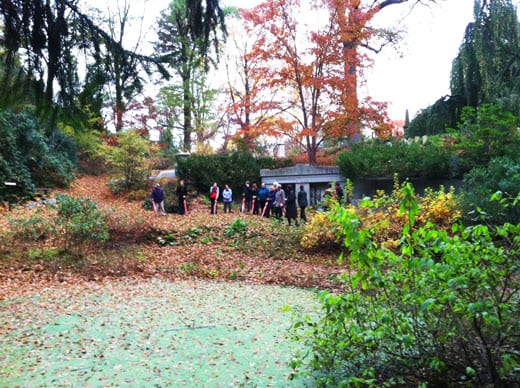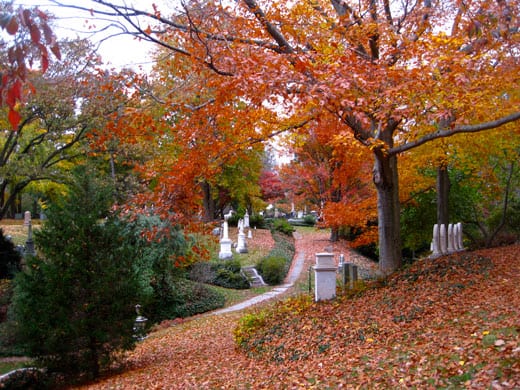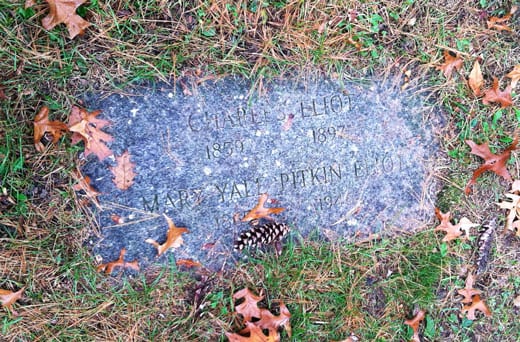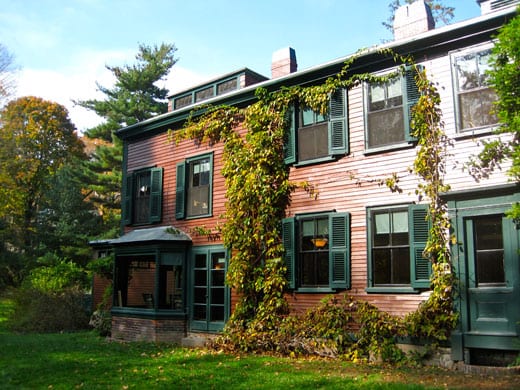REFLECTIONS ON OUR 20TH
The morning after celebrating LALH’s twentieth anniversary at the Boston Athenaeum, we found ourselves standing in the Dell of Mount Auburn Cemetery, under a soft, dark October sky. At that moment, at least to me, it felt that the very roots of LALH could be traced back to this silent and moving place.

Mount Auburn, still one of the most beautiful designed landscapes in North America, traces its origins to 1831, a time when American graveyards were grim, foul-smelling places. The idea that a parklike cemetery, laid out with aesthetic principles in mind, could provide a healing connection to Nature caught on quickly. Mount Auburn soon began attracting pleasure seekers in addition to mourners, and before long, A. J. Downing and others were advocating for a park for the living, constructed centrally in New York. The ideas that inspired the layout of these places, particularly the notion that contact with nature could mend body and soul, continued to guide American landscape designers through the nineteenth and twentieth centuries.

We ended our tour at the grave site of Charles Eliot, whose headstone is among the least pretentious of any in this Silent City on a Hill. He lies at the foot of a magnificent white pine, one of the species brought into the nursery trade just about the time that Eliot was born, 1859. Eliot’s brilliant understanding of history and his own sharp response to nature gave rise to a web of ideas so sophisticated that it has taken scholars more than a century to untangle them. At LALH, we’re still working on it.

These ideas gave rise to miraculous designs in Boston and beyond and to an organization that holds beautiful places in trust for the public good, The Trustees of Reservations. We are just beginning to understand the threads of influence that connected Eliot to his times, his astoundingly talented colleagues, and subsequent generations of American landscape architects like Fletcher Steele.

This past weekend, I came across a letter from Steele to his father dated January 27, 1912. I was stunned anew by how much Steele understood, even as a young man, about the origins of this amazing profession:
Thirty years ago there was practically but one landscape architect and he a pioneer—Frederick Law Olmsted. That extraordinary genius had conceived years before the need . . . for landscape architects, and in his own lifetime anticipated almost all the functions of the profession as it exists today. He was by nature a passionate reformer, in sympathy with all people both rich and poor, cognizant through rare qualities of observation with the wretched chaos of existing conditions with regard
to . . . bad city arrangements (including bad sanitation, congestion, fire danger, lack of recreation facilities, senseless and expensive planning of streets, railroads, waterfronts, etc., The ugliness and provincialism and all the else that progressive places are now awake to). He realized the predicament in which agriculture was falling, the draining of the resources of the land by bad farming methods. The needs of agricultural and vocational schools & and other means of educating the people and the dangers of the falling proportion of agricultural population. He exhorted against the exploitation and waste of natural resources, & was a herald of the modern conservation movement. He was a great lover of beauty, and realized the great future of architecture and the arts in America long before there were more than two or three American architects & artists worthy of the name. He was trained a practical farmer, & retained many of the Yankee qualities to the end of his life. The ability to size up conditions as they existed & the need of fitting any changes as closely and economically as possible to such conditions. Finally he was a great lover of God’s Out-of-Doors & the beauty of Nature, with a technical knowledge & appreciation of native American scenery. Remember that all these matters that are commonplace today, and many others of which I have not spoken, he was practically the first man to think out, and tell the people.
From this man’s work sprang my profession. . . .